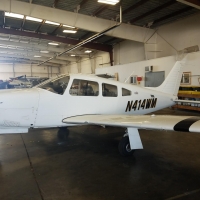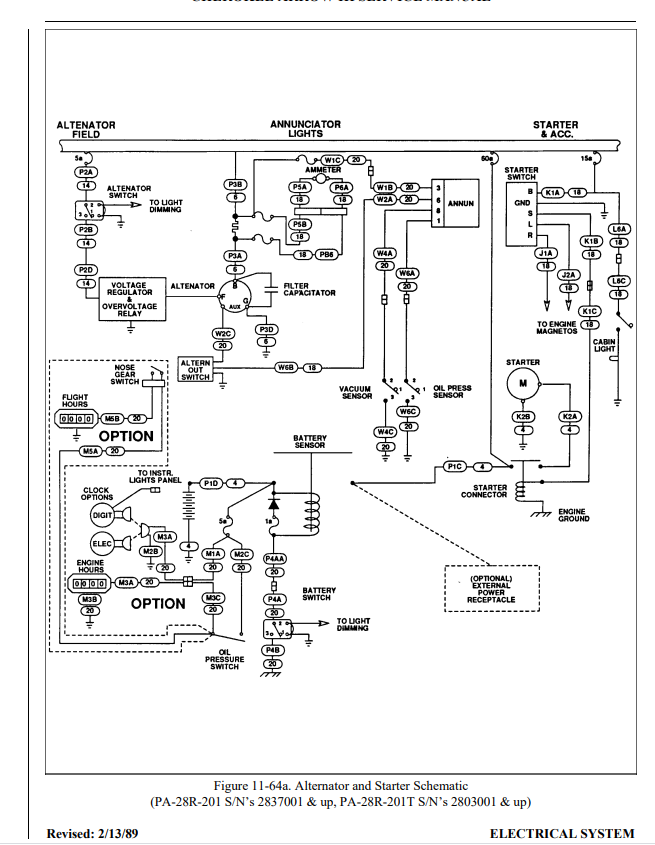Alternator Inop Lamp Weak
Recently had a full electrical failure, fortunately it was Day VFR. The airplane was on downwind, and after putting the gear down, lost the radios and all electronics. Dark panel. On final received a RED light from the tower. Performed a go around and received a Green light from the Light gun and landed. After shut down tried to restart the engine. Dead battery. This is a 2004 Arrow III, PA-28R-201.
The A&P arrived 2 days later to look at the problem. As per his instructions I had the battery on a charger for several hours prior to his arrival. He tested everything and could not find anything wrong in the electrical system. Even the battery was good and not in need of replacement. His assessment is that the alternator had tripped off in flight for some reason and was not noticed or reset as per the electrical failure checklist. Excuses include; Bright CAVU weather in the Arizona sunshine while practicing VFR Commercial Pilot maneuvers, eyes up and outside the cockpit.
Another interesting component in the chain, is that the mechanic discovered that the "Alternator Out Lamp" on the annunciation panel, does not illuminate very brightly when the alternator is turned off with the engine running. However it does display as brightly as the Oil & Vacuum lamps when it it tested with the Annuniciator test button.
Is this something that can be fixed or is this normal for this lamp to display less brightly when activated by an alternator failure or disabled by the alternator On/Off switch? Is there a part that needs to be replaced in the electrical wiring system and if so what is the part name and number.
Sincerely yours, for a safer G.A.
Bristowe Pitts


Comments
The dim display is normal, sorry. However, you can connect a second annunciator light in parallel with the first. Here's a link. https://www.aircraftspruce.com/catalog/inpages/al1RED.php?clickkey=5011821
Scott Sherer
Wright Brothers Master Pilot, FAA Commercial Pilot
Bristowe;
I had a similar experience. It was winter, and I flew a 2 1/2 hr flight to MI. I parked the plane and plugged in the engine heater. I returned to the plane after only 2 - 3 hrs. The starter spun so slowly it would not engage the Bendix nor turn the propeller. There was not heavy grease on the shaft of the starter, nor was it that cold, but it behaved like your plane with a weak battery. My wife (who was already in MI) drove me to the local auto parts store where I picked up jumper cables and a car battery. I jumped the airplane and it started immediately confirming that the Bendix was not bound up. I needed to stop for fuel on the way home so I kept the battery and cables with me in case the engine wouldn't start after the fuel stop. The engine fired immediately after the fuel stop without jumping, and I flew home without a single problem. At home, we pulled the battery and my A&P performed a load test. It showed 97% capacity, so the battery was ruled out. A month later during the annual, we inspected the starter, the wiring, master/alt switch, and checked voltage drops, but found nothing. We agreed that even if the battery was weak prior to departure, a 2 1/2 hr trip should have been plenty of time to charge up. We came to a conclusion similar to your A&P that something may have tripped the alt off line, but like you, I never saw an annunciator light come on and my radios continued to work. The problem has never reoccurred. I'm chalking it up to a weak connection somewhere that was disassembled and reseated during the annual.
Jim "Doc Griff" Griffin
PA28 - 161
Chicago area
Interesting story Jim, thank you for sharing. It makes feel better as a PIC that I am not the only one who did not notice this warning lamp. I now point out to every new club member, during their orientation, the difference in the ALT Warning lamps brightness when the ALT switch is shut off compared to when the TEST button for the annunciator panel is activated. It is much brighter during the latter and is barely perceptible on sunny days when the alternator is switched off or fails.
I am going to look for a yellow LED bulb that will fit in the same socket as the ALT Warn Lamp. I believe they are called "Bipolar" lamps ?
Sincerely yours, for a safer G.A.
Bristowe Pitts
A few things to consider, but first, a tiny bit of electronics for the group;
An incandescent lamp like we have in our aircraft, will light up with AC (alternating current), or DC (direct current), and has no polarity requirements. An LED (Light Emitting Diode) is a polarized semiconductor device that behaves like a one way valve. Like a regular diode, an LED only allows current to flow in one direction. Therefore, an LED will only light up when a forward current is applied.
1) The "bipolar" LED's, commonly referred to as multicolor, are back to back LED's. When current is applied in one direction, one color will display, and when current is applied in the opposite direction, a different color will display. If an alternating current is applied at 60 hz or greater, the LED will display both colors, and the persistence of our eyes will interpret it as a 3rd color. Red one direction, green the other, red+green appears yellow.
Our aircraft are primarily DC, meaning the current only flows in one direction, so a multi color LED, will only display 1 color.
2) If you choose to go with an LED annunciator lamp, make sure it is an approved part. I just did a quick search on Aircraft Spruce for LED bulbs. When I filtered the search to look for "Certified", "PMA", "STC" or "TSO", only landing lights, nav markers, and a couple instrument lights came up.
If you find a suitable approved LED, I would purchase either white or red. The lens in the annunciator panel is already red, so white or red will maintain the correct color.
Your choice to go LED is a great idea. It appears the industry and the FAA need to work together and get some LED lamps through the approval process.
Jim "Doc Griff" Griffin
PA28 - 161
Chicago area
All of the above is based on my assumption that this is a 12-volt system, not a 24-volt system, and that your annunciator panel is like the one used in later model aircraft.
Normally when you press the TEST button, the ALT lamp should be much brighter than the VAC and OIL lamps. If they are similar brightness, it's highly likely the ALT lamp is the wrong voltage.
An LED us not a good idea as a ALT annunciator. The reason for this is a much longer explanation than I care to get into here.
VFRs,
The other challenge with the annunciator panel is the incandescent bulbs can get hot enough to melt the Plexiglas cover as distort it.
I would also recommend a 12V cigarette lighter plug with a display on the voltage and two USB ports

Like this. I bough this one for a boat application and it works well.
Regarding the battery, I would insist on it being load tested to make sure it has sufficient capacity. Deep discharge events cause damage to capacity and it is possible it reads all the right voltages, starts the plane, but does not have capacity if the alternator fails.
Did the alternator trip the breaker? Is there a backup panel breaker? I am concerned it could happen again and the next time you would need to do an emergency extension.
I don't think the alternator has an auto resetting breaker. Here is a PA28R-201 wiring diagram. I have highlighted in yellow the resistor to ground for the alternator warning.
If there is no voltage from the alternator then the current flows from the bus, through the light, through a diode and then the resistor to ground. If the the voltage from the alternator is correct the light will be off and no current will flow.
If the light is weakly on then it is possible the alternator is providing partial voltage instead of full voltage/current. I would suspect the alternator, the OV relay or the regulator. I am not convinced at all that this problem is solved for you. It is also possible the maneuvers for the commercial rating caused an issue too. I would focus on the field wiring. If the alternator output or battery had a short you would definitely have had smoke in the cockpit (unless at the alternator terminals). Since it seems the alternator is charging now the most likely is a problem with the field circuit. It would be great to have a monitor for the field voltage but the next best is the bus voltage.
The piper current meter shows current from the alternator but not the next balance to/from the battery. The only indication of charge state is really the bus voltage and the since it is not part of the stock config you need to use something like a cigarette lighter plug. If you have an electronic engine monitor often it can be configured to give battery warnings too.
Eric Panning
1981 Seneca III
Hillsboro, OR (KHIO)
Very well written response. I didn't want to go into a long winded discussion of mismatched current loads, bias voltages/currents, constant vs. variable voltage drops, etc. either. 🙄
It'd just make everyone's eyes glass over. 😂
Jim "Doc Griff" Griffin
PA28 - 161
Chicago area
Jim, thanks Bristow has a newer plane too. I found a more current layout but it might still be outdated vs 2004. principles are the same though.
Bristow has a newer plane too. I found a more current layout but it might still be outdated vs 2004. principles are the same though.

Eric Panning
1981 Seneca III
Hillsboro, OR (KHIO)
Thanks to all that responded to my issue with the Alternator Warning Lamp on the annunciator panel. I liked the idea of using the USB adapter with voltage read out but unfortunately they did not put cigarette lighter/ power supply outlets on the instrument panels of 2004 Arrows.
I ended up getting a LED bulb from A/C Spruce and that solved the problem. It now illuminates bright when tested, and it illuminates bright when I turn off the alternator switch with the engine running. So I am proceeding with the assumption that it is going to Illuminate brightly the next time the alternator actually fails.
Sincerely yours, for a safer G.A.
Bristowe Pitts
Bristowe;
Excellent, glad to hear it's fixed.
Thanks for the follow-up!
Jim "Doc Griff" Griffin
PA28 - 161
Chicago area